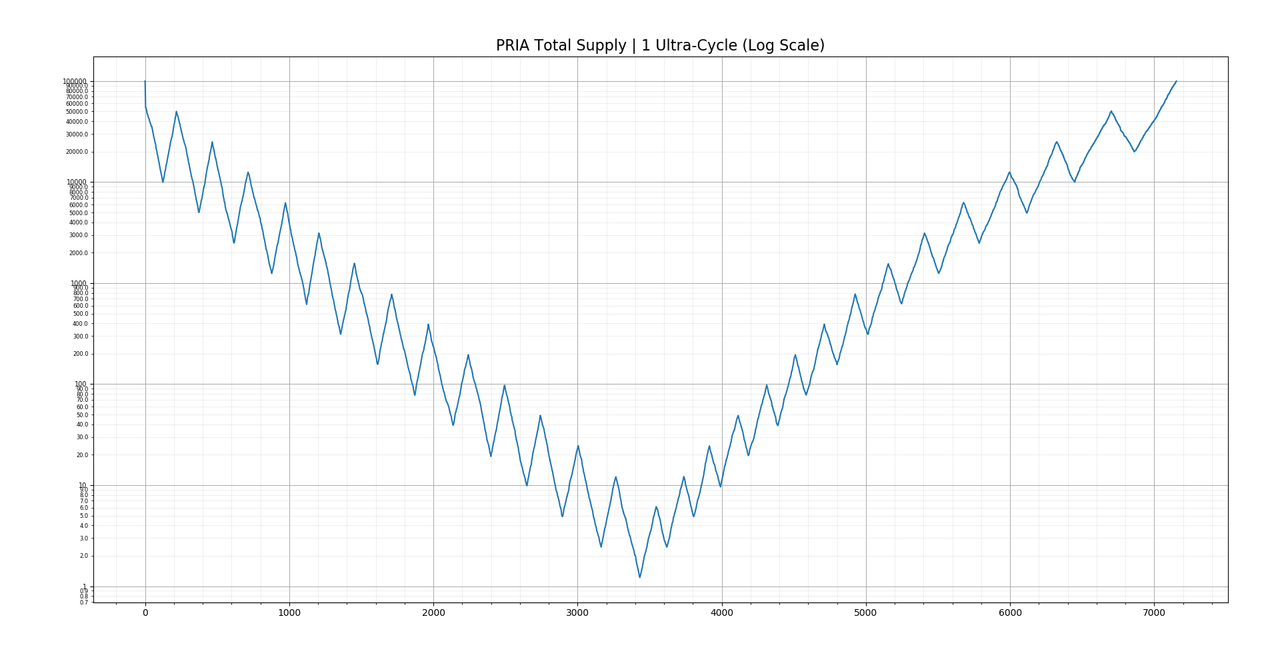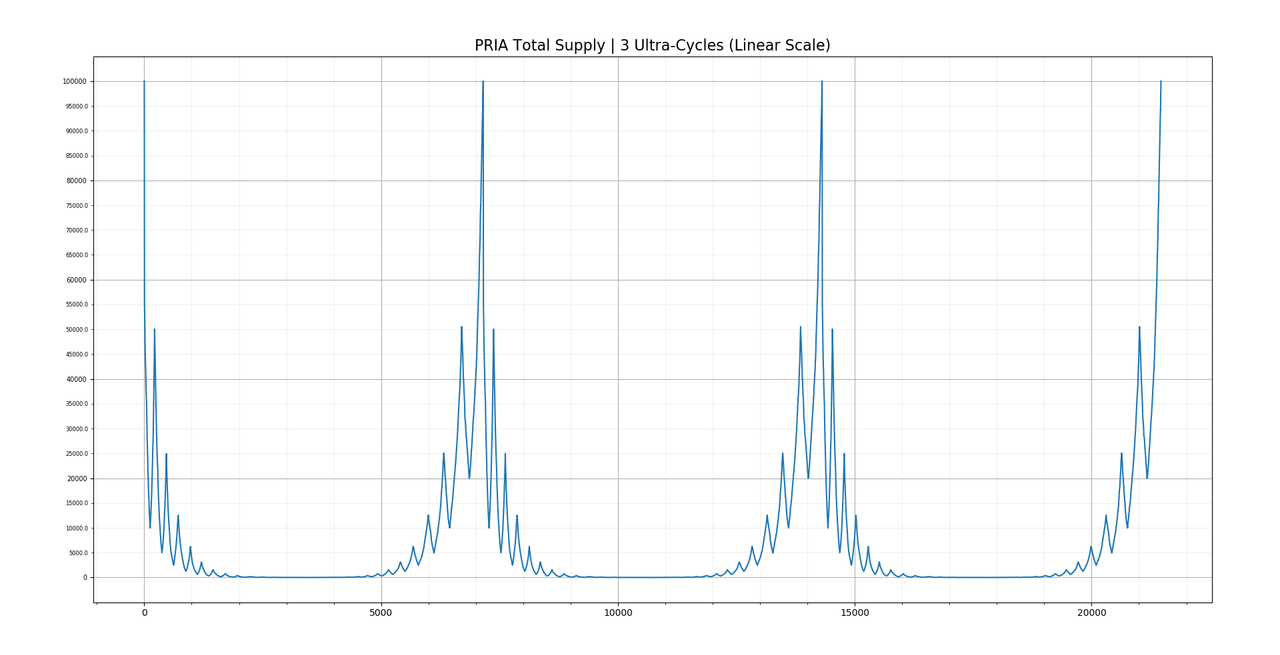PRIA
PRIA is a fully automated and decentralized digital asset that implements and manages a perpetual ultra-deflationary monetary policy favourable to inflation arbitrage by market participants.
Please make sure you understand PRIA before using it. There is a built-in inactivity burn rule that may result in partial or complete permanent loss if disregarded.
Buy Now
Dashboard
Total Supply
Max Supply
Min Supply
Market Cap
Airdrop Address Balance
Current Airdrop Queue Ticket
Current Turn
Project Info
PRIA
Warning: PRIA has a built-in mechanism to enforce its ultra-deflationary policy. Ignoring this feature can lead to permanent loss. Please read carefully about the inactivity burn. What is the inactivity burn?
EthereumERC-20DeFiVyper 
| Contract: | 0xb9871cb10738eada636432e86fc0cb920dc3de24 |
| Maximum Supply: Dynamic |
12.2 PRIA - 100,000 PRIA* *Defined per turn |
| Minimum Supply: Dynamic |
1.2 PRIA - 10,000 PRIA* *Defined per turn |
| Created by: | Dr. Mantis |
PRIA features resumed:
- Maximum supply is capped at 100,000 PRIA.
- Circulating supply starts at 100,000 PRIA.
- 1.25% of every transaction will be burned.
- 0.85% of every transaction goes to an airdrop address.
- 0.50% of every transaction goes to the owner, marketing and liquidity incrementation.
- The airdrop address stops receiving funds if its balance exceeds 5% of the total supply to prevent becoming too large.
- The owner address stops receiving funds if its balance exceeds 1.5% of the total supply to force market participation and prevent becoming too large
- A minimum amount per trade/transfer of 0.25% of the balance of the airdrop wallet is required in order to qualify for the airdrop.
- Airdrops are programmatically delivered from the airdrop address after 200 transactions* have passed. Airdrops are delivered to the person who last qualified 200 transactions in the past.
*Qualified for the airdrop transactions. - Airdrop amounts are increased dynamically when the airdrop address holds 2% of the total supply.
- Airdrop amounts are decreased dynamically when the airdrop address holds less than 1% of the total supply.
- A minimum supply of 10,000 PRIA is set (Turn 1).
- When supply goes from the maximum supply to the minimum supply, that is called 1 Turn and vice-versa.
- Once the total supply reaches the minimum supply level, the turn ends and a new turn gets started. In the new turn it stops burning and starts minting towards the maximum supply level. The minting is done every transaction and is given to the wallet of the person emitting the transaction.
- The burn and airdrop rates increase every airdrop until the minimum supply is reached, once the new turn gets initiated, these rates go back to back to the the initial conditions.
- The minting rate increases and decreases with the burn rate even if minting is inactive.
- When the maximum supply is reached, a new turn is initiated, minting stops, burning starts, and the burn and airdrop rates start rising.
- A fail-safe condition has been set in case the burn, mint and airdrop rates get too high (10%) over time and so it defaults to the initial rates. Likewise, a fail-safe condition has been set in case the burn, mint and airdrop rates get too low. (1% burn/mint)
- A macro contraction is the extended period of decreasing supply from 100,000 PRIA towards 1.2 PRIA, conversely, a macro expansion is the extended period of increasing supply from 1.2 PRIA to 100,000 PRIA.
- During a macro contraction, the maximum supply gets halved when the minimum supply is reached and the minimum supply gets halved when the maximum supply is reached. During a macro expansion, this dynamic is inverted
 There is an inactive burn system in place. This is of extreme importance if you plan on holding PRIA. Every transaction time is recorded and if a user does not make a single transfer or buy trade in the span of 35 days, any person can call a function that will burn 25% of the tokens in that address. If the inactivity lasts for 60 days, then the inactivity burn rate increases to 100%. This is a necessary measure to prevent tokens to get stuck on wallets and assure that the ultra-deflationary policy resumes as planned. You can double check your timestamps on pria.network or on the Etherscan.
There is an inactive burn system in place. This is of extreme importance if you plan on holding PRIA. Every transaction time is recorded and if a user does not make a single transfer or buy trade in the span of 35 days, any person can call a function that will burn 25% of the tokens in that address. If the inactivity lasts for 60 days, then the inactivity burn rate increases to 100%. This is a necessary measure to prevent tokens to get stuck on wallets and assure that the ultra-deflationary policy resumes as planned. You can double check your timestamps on pria.network or on the Etherscan. There is an inactive burn system in place for contract addresses. If a contract is inactive for 60 days, then anyone can call a function that will burn 25% of the balance within that contract. If the inactivity time is 90 days then the inactivity burn gets increased to 100%. Aside from this measure leading to enforcement of the ultra-deflationary monetary policy, it also acts as a safeguard against flash crashes associated with flash loans. Because of this measure, you should think well before locking your funds in an address that will not do any PRIA transfers for the stipulated times. You can double check your timestamps on pria.network or on the Etherscan.
There is an inactive burn system in place for contract addresses. If a contract is inactive for 60 days, then anyone can call a function that will burn 25% of the balance within that contract. If the inactivity time is 90 days then the inactivity burn gets increased to 100%. Aside from this measure leading to enforcement of the ultra-deflationary monetary policy, it also acts as a safeguard against flash crashes associated with flash loans. Because of this measure, you should think well before locking your funds in an address that will not do any PRIA transfers for the stipulated times. You can double check your timestamps on pria.network or on the Etherscan. The Uniswap liquidity smart contract is a whitelisted address in order to prevent liquidity leaks. As such, when a sell is made to Uniswap, Uniswap won't contribute to burning of PRIA. Likewise, selling PRIA to Uniswap doesn't reset the timer on the seller. Only buys and normal transfers reset the inactivity timer.
The Uniswap liquidity smart contract is a whitelisted address in order to prevent liquidity leaks. As such, when a sell is made to Uniswap, Uniswap won't contribute to burning of PRIA. Likewise, selling PRIA to Uniswap doesn't reset the timer on the seller. Only buys and normal transfers reset the inactivity timer.- If the airdrop address stays inactive for 1 week, any user can call a function that will burn 25% of the airdrop address balance.
 Due to the burning systems operating on PRIA, it is important to note that if you buy PRIA, and send it to another address who never made a PRIA buy or transfer. Their inactivity timer won't be initialized and therefore inactivity burns can happen promptly. To avoid this, the new address has to make its first buy to register itself as active. You can double check your timestamps on pria.network or on the Etherscan.
Due to the burning systems operating on PRIA, it is important to note that if you buy PRIA, and send it to another address who never made a PRIA buy or transfer. Their inactivity timer won't be initialized and therefore inactivity burns can happen promptly. To avoid this, the new address has to make its first buy to register itself as active. You can double check your timestamps on pria.network or on the Etherscan.- The owner wallet isn't immune to the inactivity burn, only the uniswap router and uniswap factory contracts are excluded from the inactivity burn as these will be the addresses that facilitate trade.
- There are a set of manager functions that give the owner address, additional privileges to manage the launch phase. After Saturday, October 17, 2020 at 12:00 AM GMT, anyone will be able to call the manager kill switch function, at which point, the project goes full DeFi.
PRIA has been back-tested multiple times on a sandbox environment. More than 1M transactions have been simulated.

Total Supply Projections
The following graphs show the results of the last performed simulation of PRIA where random transactions were generated. As each transaction gets submitted, the smart contract adjusts the supply to match de ultra-deflationary monetary policy.
What is a macro-contraction and macro-expansion?
A macro-contraction is the stage in which PRIA reduces its total supply from 100,000 PRIA to 1.2 PRIA. A macro-expansion is when PRIA increases its total supply from 1.2 PRIA to 100,000 PRIA. Macro-contractions and macro-expansions are made up of several micro contractions and micro expansions, these are also called turns. To find out in which turn PRIA is, you can check the read contract section on Etherscan.
What is an ultra-cycle?
An ultra-cycle is composed of a macro-contraction and a macro-expansion, thus, an ultra-cycle commences and ends when the total supply is at 100,000 PRIA. See the legend below.


An ultra-cycle on a linear scale. Click on the graph for the full resolution version.
Ultra-cycles may become hard to read when the supply range is in the double-digit range. By plotting the same graph on a logarithmic scale the turns become more clear.

An ultra-cycle on the logarithmic scale. The maximum and minimum supply is adjusted during micro-contractions and micro-expansions (turns). The minimum supply and maximum supply will continously halve during macro-contractions. Conversely, during the macro-expansion, the minimum supply and maximum supply will continously double every micro-contraction and micro-expansion (turns).

What happens at the end of an ultra-cycle?
It continues, forever.

Cyclical ultra-cycles on the logarithmic scale.